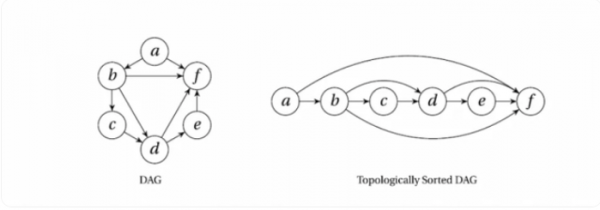|
|
拓扑排序是一种把有向无环图转换成线性序列的排序算法,算法的输入是一个有向无环图,经过算法分析吧图中的所有节点按照先后顺序进行拆解,最后得到一个有顺序的队列,在前的节点靠前,越靠后的节点或有多个节点指向该节点,那这个节点再队列中的位置就越靠后。

拓扑排序,分别用C语言,C++,java,python编写出来
下面是拓扑排序(Topological Sort)的不同语言实现示例:
1. C语言:
- #include <stdio.h>
- #define MAX_SIZE 100
- void topologicalSort(int graph[][MAX_SIZE], int n) {
- int indegree[MAX_SIZE] = {0};
- int queue[MAX_SIZE];
- int front = 0, rear = 0;
- // 计算每个顶点的入度
- for (int i = 0; i < n; i++) {
- for (int j = 0; j < n; j++) {
- indegree[i] += graph[j][i];
- }
- }
- // 将入度为0的顶点入队列
- for (int i = 0; i < n; i++) {
- if (indegree[i] == 0) {
- queue[rear++] = i;
- }
- }
- // 拓扑排序
- while (front < rear) {
- int vertex = queue[front++];
- printf("%d ", vertex);
- for (int i = 0; i < n; i++) {
- if (graph[vertex][i] == 1) {
- indegree[i]--;
- if (indegree[i] == 0) {
- queue[rear++] = i;
- }
- }
- }
- }
- }
int n = 6;
int graph[MAX_SIZE][MAX_SIZE] = {
{0, 0, 0, 0, 0, 0},
{0, 0, 1, 0, 0, 0},
{0, 0, 0, 1, 0, 0},
{0, 0, 0, 0, 1, 0},
{0, 1, 0, 0, 0, 0},
{1, 1, 0, 0, 0, 0}
};
printf("Topological Sort: ");
topologicalSort(graph, n);
return 0;
}
2. C++:
- #include <iostream>
- #include <queue>
- #include <vector>
- using namespace std;
- void topologicalSort(vector<vector<int>>& graph) {
- int n = graph.size();
- vector<int> indegree(n, 0);
- queue<int> q;
- // 计算每个顶点的入度
- for (int i = 0; i < n; i++) {
- for (int j = 0; j < n; j++) {
- indegree[i] += graph[j][i];
- }
- }
- // 将入度为0的顶点入队列
- for (int i = 0; i < n; i++) {
- if (indegree[i] == 0) {
- q.push(i);
- }
- }
- // 拓扑排序
- while (!q.empty()) {
- int vertex = q.front();
- q.pop();
- cout << vertex << " ";
- for (int i = 0; i < n; i++) {
- if (graph[vertex][i] == 1) {
- indegree[i]--;
- if (indegree[i] == 0) {
- q.push(i);
- }
- }
- }
- }
- }
int n = 6;
vector<vector<int>> graph = {
{0, 0, 0, 0, 0, 0},
{0, 0, 1, 0, 0, 0},
{0, 0, 0, 1, 0, 0},
{0, 0, 0, 0, 1, 0},
{0, 1, 0, 0, 0, 0},
{1, 1, 0, 0, 0, 0}
};
cout << "Topological Sort: ";
topologicalSort(graph);
return 0;
}
3. Java:
- import java.util.*;
- public class TopologicalSort {
- public static void topologicalSort(int[][] graph) {
- int n = graph.length;
- int[] indegree = new int[n];
- Queue<Integer> queue = new LinkedList<>();
- // 计算每个顶点的入度
- for (int i = 0; i < n; i++) {
- for (int j = 0; j < n; j++) {
- indegree[i] += graph[j][i];
- }
- }
- // 将入度为0的顶点入队列
- for (int i = 0; i < n; i++) {
- if (indegree[i] == 0) {
- queue.add(i);
- }
- }
- // 拓扑排序
- while (!queue.isEmpty()) {
- int vertex = queue.poll();
- System.out.print(vertex + " ");
- for (int i = 0; i < n; i++) {
- if (graph[vertex][i] == 1) {
- indegree[i]--;
- if (indegree[i] == 0) {
- queue.add(i);
- }
- }
- }
- }
- }
-
- }
int n = 6;
int[][] graph = {
{0, 0, 0, 0, 0, 0},
{0, 0, 1, 0, 0, 0},
{0, 0, 0, 1, 0, 0},
{0, 0, 0, 0, 1, 0},
{0, 1, 0, 0, 0, 0},
{1, 0, 0, 0, 0, 0}
};
System.out.print("Topological Sort: ");
topologicalSort(graph);
}
4. Python:
- from collections import deque
- def topological_sort(graph):
- n = len(graph)
- indegree = [0] * n
- queue = deque()
- # 计算每个顶点的入度
- for i in range(n):
- for j in range(n):
- indegree[i] += graph[j][i]
- # 将入度为0的顶点入队列
- for i in range(n):
- if indegree[i] == 0:
- queue.append(i)
- # 拓扑排序
- while queue:
- vertex = queue.popleft()
- print(vertex, end=" ")
- for i in range(n):
- if graph[vertex][i] == 1:
- indegree[i] -= 1
- if indegree[i] == 0:
- queue.append(i)
- # 主函数
- # 下面隐藏代码为主函数
- # 调用主函数
- if __name__ == "__main__":
- main()
n = 6
graph = [
[0, 0, 0, 0, 0, 0],
[0, 0, 1, 0, 0, 0],
[0, 0, 0, 1, 0, 0],
[0, 0, 0, 0, 1, 0],
[0, 1, 0, 0, 0, 0],
[1, 1, 0, 0, 0, 0]
print("Topological Sort: ", end="")
topological_sort(graph)
这些示例展示了使用不同编程语言实现拓扑排序算法的方式。请根据您选择的编程语言,使用相应的示例来实现拓扑排序算法。

扫码关注微信公众号,免费查看完整算法内容。
|
|